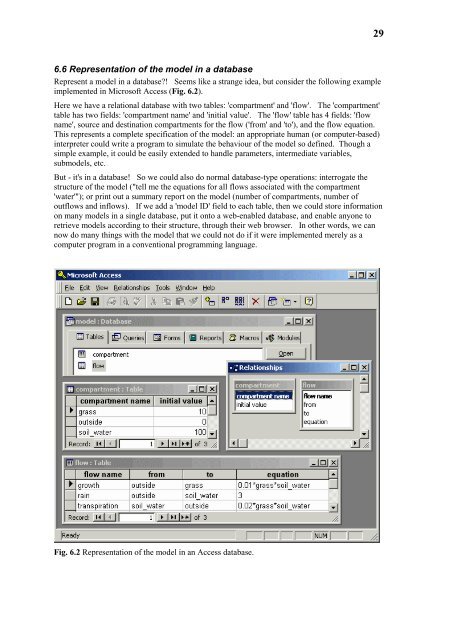pdf: 600KB - Potsdam Institute for Climate Impact Research
pdf: 600KB - Potsdam Institute for Climate Impact Research
pdf: 600KB - Potsdam Institute for Climate Impact Research
You also want an ePaper? Increase the reach of your titles
YUMPU automatically turns print PDFs into web optimized ePapers that Google loves.
29<br />
6.6 Representation of the model in a database<br />
Represent a model in a database?! Seems like a strange idea, but consider the following example<br />
implemented in Microsoft Access (Fig. 6.2).<br />
Here we have a relational database with two tables: 'compartment' and 'flow'. The 'compartment'<br />
table has two fields: 'compartment name' and 'initial value'. The 'flow' table has 4 fields: 'flow<br />
name', source and destination compartments <strong>for</strong> the flow ('from' and 'to'), and the flow equation.<br />
This represents a complete specification of the model: an appropriate human (or computer-based)<br />
interpreter could write a program to simulate the behaviour of the model so defined. Though a<br />
simple example, it could be easily extended to handle parameters, intermediate variables,<br />
submodels, etc.<br />
But - it's in a database! So we could also do normal database-type operations: interrogate the<br />
structure of the model ("tell me the equations <strong>for</strong> all flows associated with the compartment<br />
'water'"); or print out a summary report on the model (number of compartments, number of<br />
outflows and inflows). If we add a 'model ID' field to each table, then we could store in<strong>for</strong>mation<br />
on many models in a single database, put it onto a web-enabled database, and enable anyone to<br />
retrieve models according to their structure, through their web browser. In other words, we can<br />
now do many things with the model that we could not do if it were implemented merely as a<br />
computer program in a conventional programming language.<br />
Fig. 6.2 Representation of the model in an Access database.
















